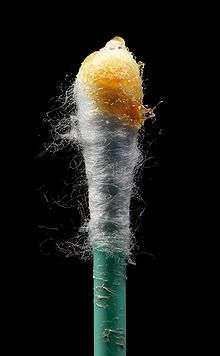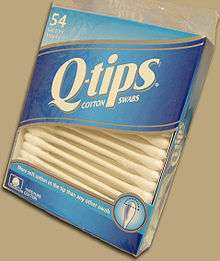Cotton swab
Cotton swabs (American English) or cotton buds (British English) are handheld items that consist of one or two small wads of cotton wrapped around one or both ends of a short rod made of wood, rolled paper or plastic. They are most commonly used for ear cleaning, although this use is not recommended by physicians.[1][2] Other uses include first aid, cosmetics application, cleaning, and arts and crafts. Concerns about marine pollution have led some countries to ban the plastic-stemmed versions in favour of biodegradable alternatives.


_-in_round_container.jpg)

History
The first mass-produced cotton swab was developed in 1923 by Polish-American Leo Gerstenzang[3] after he watched his wife attach wads of cotton to toothpicks.[4] His product, originally named "Baby Gays", "Q-tips Baby Gays", and finally just "Q-tips" (meaning quality tips) went on to become the most widely sold brand name of cotton swabs/buds. The term “Q-tips” is often used as a genericized trademark for cotton swabs in the United States and Canada.[4] The Q-tips brand is owned by Unilever and had over $200 million in US sales in 2014.[5] Johnson's buds are made by Johnson & Johnson.
Description
The traditional cotton swab has a single tip on a wooden handle, and these are still often used, especially in medical settings. They are usually relatively long, about 6 inches (15 cm). These often are packaged sterile, one or two to a paper or plastic sleeve. The advantage of the paper sleeve and the wooden handle is that the package can be autoclaved to be sterilized (plastic sleeves or handles would melt in the autoclave).
Cotton swabs manufactured for home use are usually shorter, about 3 inches (7.6 cm) long, and usually double-tipped. The handles were first made of wood, then made of rolled paper, which is still most common (although tubular plastic is also used). They are often sold in large quantities, 100 or more to a container.
Plastic swab stems exist in a wide variety of colors, such as blue, pink or green. However, the cotton itself is traditionally white.
Use
The most common use for cotton swabs is to clean or caress the ear canal and/or to remove earwax, despite this not being a medically recommended method for removing earwax. Cotton swabs are also commonly used for applying and removing makeup, as well as for household uses such as cleaning and arts and crafts. They are also handy for touching up nail polish that gets on the surrounding skin.
Medical-type swabs are often used to take microbiological cultures. They are rubbed onto or into the infected area, then wiped across the culture medium, such as an agar plate, where bacteria from the swab may grow. They are also used to take DNA samples, most commonly by scraping cells from the inner cheek in the case of humans. They can be used to apply medicines to a targeted area, to selectively remove substances from a targeted area, or to apply cleaning substances like Betadine. They are also used as an applicator for various cosmetics, ointments, and other substances.
A related area is the use of swabs for microbiological environmental monitoring. Once taken, the swab can be streaked onto an agar plate, or the contents of the tip removed by agitation or dilution into the broth. The broth can either then be filtered or incubated and examined for microbial growth.[6]
Cotton swabs are also often used outside of the field of personal hygiene:
- Often used in plastic model kits construction, for various applications during the application of decals or painting. Special brands of cotton swabs exist for this purpose, characterised by sturdier cotton heads and varied shapes of those heads.
- Can be used in the dyne test for measuring surface energy. This use is problematic, as manufacturers differ in the binders they use to fix the cotton to the stem, affecting the outcome of the test.[7]
- They are frequently used for cleaning the laser diode lens of an optical drive in conjunction with rubbing alcohol. Similarly, they're used for cleaning larger computer parts such as video cards, and fans. They were also used widely in the past to clean video game cartridges.
Medical risks
The use of cotton swabs in the ear canal has no associated medical benefits and poses definite medical risks.[8][9] Cerumen (ear wax) is a naturally occurring, normally extruded product of the external auditory canal that protects the skin inside the ear, serves beneficial lubrication and cleaning functions, and provides some protection from bacteria, fungi, insects, and water.[10][11]
Attempts to remove cerumen with cotton swabs may result in cerumen impaction, a buildup or blockage of cerumen in the ear canal, which can cause pain, hearing problems, ringing in the ear, or dizziness, and may require medical treatment to resolve.[8] The use of cotton swabs in the ear canal is one of the most common causes of perforated eardrum, a condition which sometimes requires surgery to correct.[12]
A 2004 study found that the "[u]se of a cotton-tip applicator to clean the ear seems to be the leading cause of otitis externa in children and should be avoided."[13] Instead, wiping wax away from the ear after a shower almost completely cleans the one third of the outer ear canal where earwax is made.[14] In the US between 1990 and 2010, an estimated 263,338 children went to hospital emergency rooms for cotton swab injuries, for an estimated annual hospitalization of 13,167 children.[15]
Environmental impact
Plastic cotton swabs are often incorrectly flushed down the toilet, increasing the risk of marine pollution. Some manufacturers and retailers have stopped the production and sale of plastic swabs and are only selling biodegradable paper versions.[16] Several countries have introduced legislation to ban plastic stemmed cotton swabs.
Summary of plastic stemmed cotton swab bans
| Country/Union | Continent | Date | References |
|---|---|---|---|
| Europe | 2021 | [17] | |
| Europe | 2019 | [18] | |
| Europe | 2020 | [19] | |
| Europe | October 2019 (Scotland), October 2020 (England), 2021 (Wales) 2021 (Isle of Man) | [20][21][22][23] |
See also
References
| Wikimedia Commons has media related to Cotton swabs. |
- Moser, Rod (November 13, 2006), Q-Tips – Weapons of Ear Destruction?, WebMD
- Stein, Joel (March 26, 2001), "Something Evil in the Ear Canal", Time
- Schueller, Randy (1996), "Cotton Swab", How Products are Made, Volume 4, archived from the original on 2011-08-31
- About: A Q-Tips® Cotton Swabs History, Unilever United States, 2007–2018
- Fitzgerald, Dennis (24 January 2016). "How a household staple became the source of doctor's office swab stories". The Toronto Star. Retrieved 24 January 2016.
- Sandle, T. (July 2011). "A study of a new type of swab for the environmental monitoring of isolators and cleanrooms". European Journal of Parenteral & Pharmaceutical Sciences. 16 (2): 42–48.
- Edward Boyle (Sep 1, 1996). "Taking the measure of surface treatment is a learning process". PFFC: Paper, Film & Foil Converter. Retrieved 2010-03-20.
- American Academy of Family Physicians (May 2007). "Information from Your Family Doctor—Earwax: What You Should Know". American Family Physician. 75 (10): 1530. PMID 17555145.
- "Why You Really, Truly Should Not Put Q-Tips Into Your Ears". commonhealth. Retrieved 2016-03-06.
- McCarter, Daniel F.; et al. (May 2007). "Cerumen Impaction". American Family Physician. 75 (10): 1523–1528. Retrieved 5 September 2012.
- Earwax at the American Hearing Research Foundation. Chicago, Illinois 2008.
- Smith, Matthew; Darrat (February 2012). "Otologic complications of cotton swab use: One institution's experience". The Laryngoscope. 122 (2): 409–411. doi:10.1002/lary.22437.
- Nussinovitch, Moshe; et al. (April 2004). "Cotton-tip applicators as a leading cause of otitis externa". International Journal of Pediatric Otorhinolaryngology. 68 (4): 433–435. doi:10.1016/j.ijporl.2003.11.014. PMID 15013609. Retrieved 5 September 2012.
- "Don't use cotton-tipped swabs to clean inside your ears, experts urge". CBC News. Retrieved 2018-01-10.
- Ameen, Zeenath S. (1 May 2017). "Pediatric Cotton-Tip Applicator-Related Ear Injury Treated in United States Emergency Departments, 1990–2010". The Journal of Pediatrics. 186: 124–130. doi:10.1016/j.jpeds.2017.03.049. PMID 28473166. Retrieved 10 May 2017.
- Johnston, Ian (13 February 2017). "Johnson & Johnson will stop selling plastic cotton buds in half the world to help cut marine pollution". The Independent. Retrieved 26 November 2006.
- Moore, Darrel (28 March 2019). "European Parliament Approves Law To Ban Single-Use Plastics". CIWM Journal Online. Retrieved 28 March 2019.
- "Italy to ban microplastics used in rinse-off cosmetics products". ChemicalWatch.com. Archived from the original on 19 July 2018. Retrieved 19 June 2018.
- "Combating Plastics in Monaco: On 1 January, Plastic Cotton Buds, Cups, Cutlery and Plates wereBanned". January 6, 2020.
- https://www.bbc.co.uk/news/uk-scotland-50016878
- "Ban on plastic straws in England pushed back to October 2020". Edie. 2019-05-22. Retrieved 2020-04-16.
- https://www.edie.net/news/11/Straws--stirrers-and-cutlery--Wales-unveils-plans-to-ban-single-use-plastics-from-2021/
- "Manx government proposes ban on single-use plastics". BBC News. 24 July 2019. Retrieved 1 August 2019.